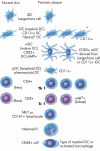Psoriasis pathophysiology: current concepts of pathogenesis
- PMID: 15708932
- PMCID: PMC1766865
- DOI: 10.1136/ard.2004.031120
Psoriasis pathophysiology: current concepts of pathogenesis
Abstract
Psoriasis vulgaris is a common skin disorder characterised by focal formation of inflamed, raised plaques that constantly shed scales derived from excessive growth of skin epithelial cells. The disease is defined by a series of linked cellular changes in the skin: hyperplasia of epidermal keratinocytes, vascular hyperplasia and ectasia, and infiltration of T lymphocytes, neutrophils, and other types of leucocyte in affected skin. In a relatively short period, psoriasis vulgaris has been conceptualised as a T lymphocyte mediated autoimmune disease and new biological therapies that target T cells have just entered routine clinical practice. Similarly, rapid progress has been made towards dissecting cellular and molecular pathways of inflammation that contribute to disease pathogenesis. This short review presents current pathogenic concepts that have emerged from genetic, genomic, and cellular information obtained in basic studies and from clinical studies of selective immune targeting drugs.
Figures


Similar articles
-
Psoriasis: evolution of pathogenic concepts and new therapies through phases of translational research.Br J Dermatol. 2007 Dec;157(6):1103-15. doi: 10.1111/j.1365-2133.2007.08135.x. Epub 2007 Aug 21. Br J Dermatol. 2007. PMID: 17714560 Review.
-
[The pathogenesis of inflammatory dermatoses, especially psoriasis].Ned Tijdschr Geneeskd. 2006 Jan 28;150(4):179-83. Ned Tijdschr Geneeskd. 2006. PMID: 16471231 Review. Dutch.
-
Psoriasis vulgaris: an interplay of T lymphocytes, dendritic cells, and inflammatory cytokines in pathogenesis.Curr Opin Rheumatol. 2004 Jul;16(4):331-7. doi: 10.1097/01.bor.0000129715.35024.50. Curr Opin Rheumatol. 2004. PMID: 15201593 Review.
-
Psoriasis: from pathogenesis to novel therapeutic approaches.Clin Sci (Lond). 2011 Jan;120(1):1-11. doi: 10.1042/CS20100163. Clin Sci (Lond). 2011. PMID: 20846119 Review.
-
[Pathogenesis of psoriasis].Hautarzt. 2016 Jun;67(6):422-31. doi: 10.1007/s00105-016-3800-8. Hautarzt. 2016. PMID: 27246016 Review. German.
Cited by
-
Honey and bee venom in dermatology: A novel possible alternative or complimentary therapy for psoriasis vulgaris.Anc Sci Life. 2014 Jan;33(3):192-3. doi: 10.4103/0257-7941.144626. Anc Sci Life. 2014. PMID: 25538357 Free PMC article. No abstract available.
-
Impact of Baseline Disease Severity Over 26 and 52 Weeks of Treatment with Calcitriol Ointment 3µg/g in Patients with Mild-to-moderate Plaque Psoriasis.J Clin Aesthet Dermatol. 2012 Feb;5(2):28-33. J Clin Aesthet Dermatol. 2012. PMID: 22468170 Free PMC article.
-
Polymeric Gels and Their Application in the Treatment of Psoriasis Vulgaris: A Review.Int J Mol Sci. 2021 May 12;22(10):5124. doi: 10.3390/ijms22105124. Int J Mol Sci. 2021. PMID: 34066105 Free PMC article. Review.
-
Tumor necrosis factor-a antagonist-induced psoriasis: yet another paradox in medicine.Clin Rheumatol. 2008 Mar;27(3):377-80. doi: 10.1007/s10067-007-0789-5. Epub 2007 Nov 10. Clin Rheumatol. 2008. PMID: 17994192
-
Sea buckthorn extract in the treatment of psoriasis.Exp Ther Med. 2019 Feb;17(2):1020-1023. doi: 10.3892/etm.2018.6983. Epub 2018 Nov 16. Exp Ther Med. 2019. PMID: 30679968 Free PMC article.
References
Publication types
MeSH terms
Substances
LinkOut - more resources
Full Text Sources
Other Literature Sources
Medical

